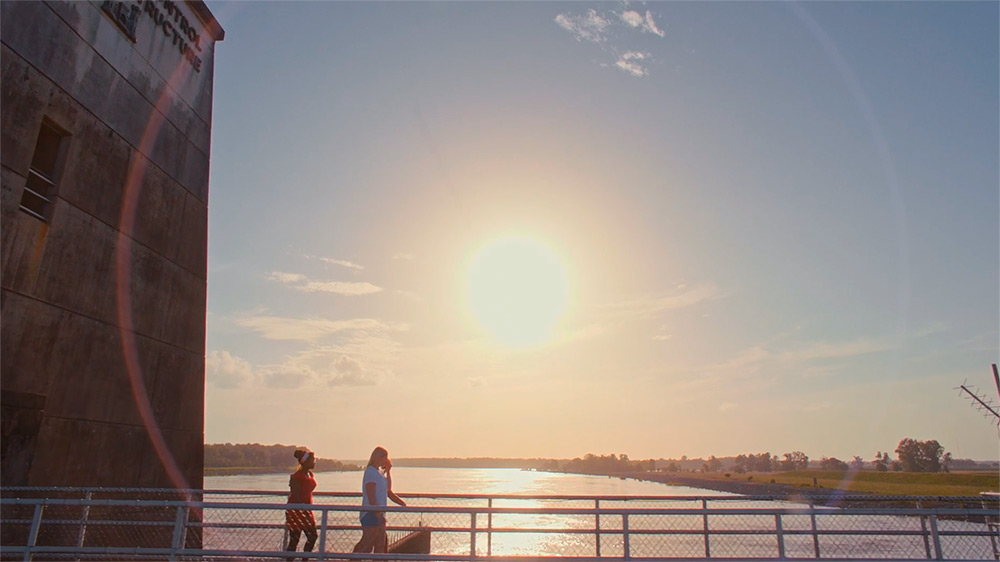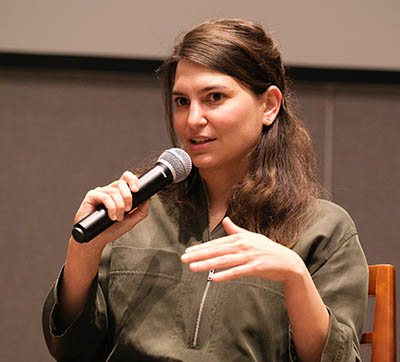
A scene from the documentary
Christina Petersen, Ph.D., began the evening with a reading of Eckerd College’s land acknowledgment.
The Christian Nielsen Professor of Film Studies, Eckerd’s co-director of the Visions of Nature/Voices of Nature Environmental Film Festival, reminded the audience at the Feb. 24 screening of Hollow Tree of the College’s core value of environmental stewardship. Then Petersen introduced Kira Akerman, the director, and Mekenzie Fanguy, one of the film’s subjects.
“Mekenzie is more than a subject in the film,” Petersen said. “She is a participant.”
Participation requires action. The three participants—Fanguy, Tanielma De Costa and Annabelle Pavy—are active in their efforts to learn about why their homes in Louisiana are being affected so drastically, and they are passionate in their conversations.
The documentary screened in the Dan and Mary Miller Auditorium featured the young women grappling with the effects of climate change in their communities. Eckerd students, faculty and community members gathered for the film’s Florida debut and took part in a post-show conversation about how climate change is connected to other systemic injustices.
The levee system, a straightjacket on the Mississippi’s natural flow, is at the heart of the film. The river naturally builds land and makes its own path, but the levees don’t allow it to move freely, which leads to excessive and unnatural flooding. The women learn about the system’s history from engineers at the Army Corps of Engineers. They ask questions about the systems currently in place, and the film portrays a defensive response. Akerman emphasizes that the value system under which the Army Corps operates predates the Corps itself. It is systemically rooted in social injustice, which is what allows injustice to survive in the actions of today.
These discussions turn the women’s attention to Louisiana’s history of slavery, indigenous dispossession, and colonization. All of these systems sought to extract, exploit and produce. The oil industry, which causes illness in proximity, is a modern example of the influence of those systems.
The film draws connections from the levee system to many other historical and contemporary complexities—such as race, the oil industry, slavery and identity. This is accomplished linguistically through conversations the women have with one another and with experts and also through the visuals that complement the words. During a conversation about the shrimping industry, to which Fanguy’s family was tied before the oil industry, the film shows a shrimp boat with very few shrimp in its nets. This image suggests that shrimping wasn’t as productive as refining cancer-causing oil.
A conversation among the women about what people wouldn’t know by looking at them calls back to their visit to the Whitney Plantation, the location of the largest slave rebellion in the U.S. South. During the visit, Pavy says, driving in front of the big house, she’d never know the history behind it. These hidden facts keep her from being her true self, she says.
Fanguy learns of her Houma ancestry. When she asks her grandfather about it, he says he is proud to be Houma.
“I just found out I was Houma Indian last week,” she says. She grapples with what this new label means for her identity.
De Costa’s experience with her roots in Angola leaves her feeling torn between two cultures. One day, she realizes she thinks in English, no longer Angolan or Portuguese. When she returns to Angola, she will feel like an outsider. The film connects the feeling of displacement to symbiotic lichens in nature. Two cultures merge within De Costa, which makes her a resurrection fern.
The meaning of the film’s title, Hollow Tree, is revealed near the end when the young women visit a cypress forest reduced to stumps. The only tall trees left have become hollow with age.
“They’re no longer useful for lumber,” Pavy says. “That’s the only way they’ve been able to survive.”
The perception of beauty in this area has changed across generations. People who remember what it was like when the trees stood tall and healthy say this forest is no longer beautiful. But those who never knew it that way see no flaws. The young women find beauty in the stumps, perhaps because they empathize with the trees’ resilience.
“My heart is strong,” are the final words of the film, sung from Pavy’s mouth.
After the credits, director Akerman and film subject Fanguy answered audience questions.
“I feel very proud of my younger self and how far I’ve come,” Fanguy said when asked how it feels to watch the film now.
But a clear divide was evident between the questions from St. Petersburg community members and Eckerd students. Students focused their questions more on film techniques.
One student was curious about Akerman’s use of archival film. While she was hesitant again to reveal her intentions, she explained her interest in making invisible forces visible. She had sought to embed the archives into the world she’d created in her film.
Community members asked questions concerning the message of the film.
“What is your call to action?” a gentleman said.
“I’d like to put that question back on you: What do you think it is?” Akerman answered.
Action in response to climate change, another audience member noted, is specific to the fears and inspiration of each community. Action looks different here in St. Petersburg than it does in Baton Rouge, Louisiana.
Another suggested the goal is to ask better questions and connect more deeply with one another as climate change continues to affect us.
“It’s not just on [young people],” Akerman said. She believes we all have a part to play in creating solutions to the issues her film spotlights.
Briana Beebe, a senior creative writing student from Centennial, Colorado, admired that answer. As an artist herself, Briana thinks it’s important for the work to communicate on its own, even when the director isn’t there to answer questions about her intentions.
“The film had some really beautiful settings,” Briana said. “Lots of huge topics were woven together so seamlessly.”













